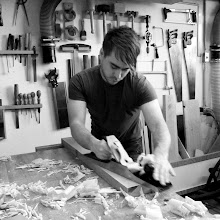Last summer, I was invited by Deborah Clemons at the RISD Museum to do an audio recording for one of the glass pieces they have in their collection. The museum wanted contemporary artists to respond to ancient pieces in their collection. Of course, I jumped at the opportunity, if not just to get a closer look at some of the ancient glass they have in their collection. By the way, they have an absolutely spectacular glass collection! The piece that I was to speak about was a beautiful and simple roman glass amphora.
The first thing that struck me about the piece is that despite having been made almost 2000 years ago, the techniques required to make the piece would be familiar to any modern beginner glassblower. I'm sure that the tools were probably more primitive (an there were probably far fewer of them), but probably very similar to those still used by craftspeople in middle eastern regions, like Israel or Afghanistan.
The more time I spent with the object, I became overwhelmed thinking about of the almost inconceivable amount time that had passed since it was pulled out of the furnace and the material that it was made of. The glass itself was mineral like. The vase was a light yellowish-green hue from impurities in the raw materials and it filled with bubbles, dirt, streaks, and striations- beautiful. The surface was wonderfully iridized, a feature that was not present when the amphora was new, but rather is the result of the surface's interaction with the environment for 18+ centuries. This type of object, although it was still probably a bit of a luxury item in it's time, was made prolifically. However, in the intervening period because of it's mere survival has transcended its makers, owners, and function. Just like minerals deep in the earth turn into jewels when subjected to time, pressure, and heat, this object is now shining man-made gem. Amazing!
The potential for longevity is one most intriguing aspects of glassmaking. Glass is incredibly inert and isn't nearly as susceptible to the elements as other materials (i.e. wood, fibers, metals, plastics, etc). If it isn't mishandled, eroded, or smashed, it can last virtually forever unchanged. I always joke that if you place a cup on a shelf as long, nothing happens to the shelf the glass will be last almost indefinitely. It's something to keep in mind, as a maker or an owner of glass. Usually I cap off my rants about sustainability making the point that we should be focused on making things that have the potential to last a very long time and that people don't want to to throw away. The next time you are picking out cups at IKEA or throwing away a wine bottle, consider that in 2000 years it could be in a museum with some yahoo, like me, wearing white gloves and drooling over it.
The amphora web page at the RISD Museum and my audio recording can be found here: RISD Museum: Pointed Amphora




No comments:
Post a Comment